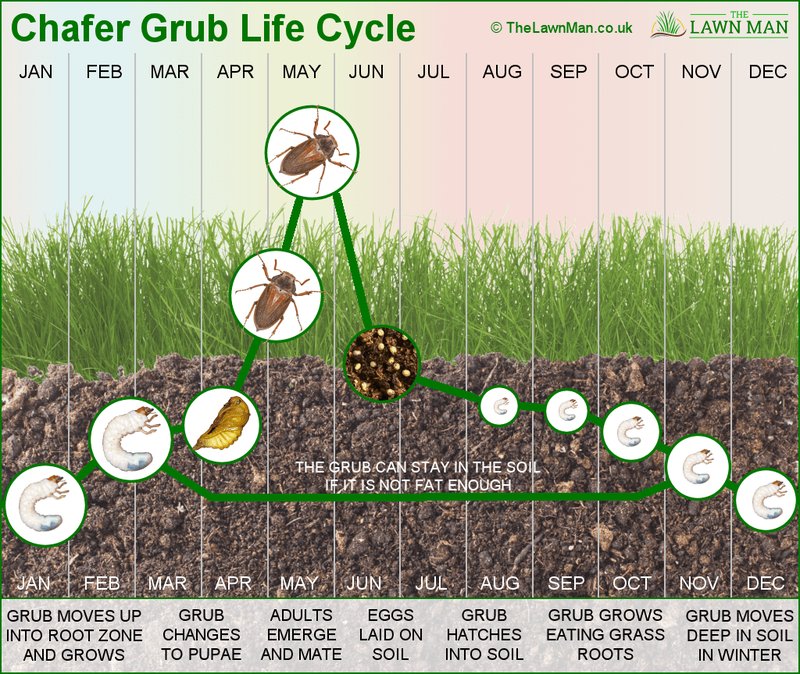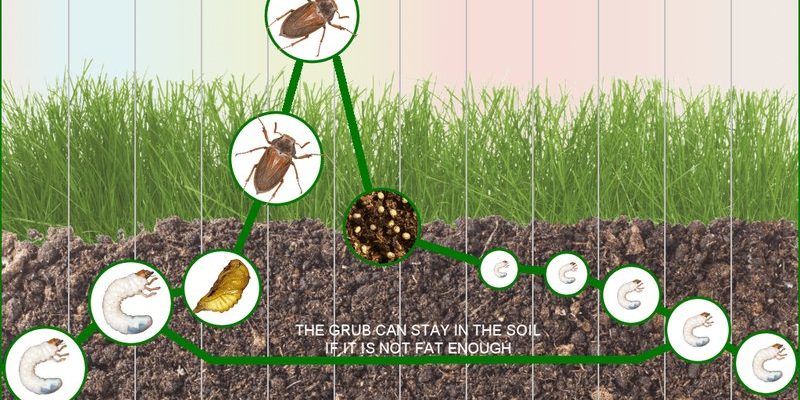
You might be wondering why you should care about these little guys. Masked chafer grubs can impact your garden and lawn care. They might even be feasting on the roots of your beloved plants! Let’s break down their lifecycle so you can understand what they are all about, when they appear, and how they affect your yard.
What Are Masked Chafer Grubs?
Masked chafer grubs are the larval stage of the masked chafer beetle, scientifically known as *Cyclocephala* species. They’re often described as white, C-shaped larvae with a soft body and a brown head. Picture a mini, wriggly gummy bear—that’s pretty close to what these grubs look like!
These critters thrive in the nutrient-rich soil of gardens and lawns. They spend most of their lives munching on roots, which may sound a bit disturbing, but it’s part of their role in the ecosystem. Although their appetite can sometimes cause issues for gardeners, they also help with breaking down organic matter, enriching the soil for future plants.
The Lifecycle Stages of Masked Chafer Grubs
Masked chafer grubs undergo a complete metamorphosis, which means they go through several distinct stages: egg, larva (the grub), pupa, and adult beetle. Let’s dive into each stage to see what happens.
1. Egg Stage
The lifecycle kicks off when the female masked chafer beetle lays her eggs in the soil, typically in late spring to early summer. Each female can lay anywhere from 20 to 60 eggs! These eggs are very tiny, so they often go unnoticed.
The eggs usually hatch within one to three weeks, depending on the temperature and moisture levels of the soil. When they hatch, the little grubs emerge and are ready to start feasting. It’s like a buffet just opened, and they can’t wait to dig in!
2. Larval Stage (Grub Stage)
Once they hatch, the masked chafer grubs enter their larval stage, where they’ll spend the next few months developing. This is the most crucial period for them. They grow by feeding on roots and organic matter in the soil, which can sometimes lead to damage in lawns and gardens.
You might notice the damage in patches where the grass looks brown or unhealthy. If you’ve ever pulled back the grass to find these little guys, you might be surprised at just how many there can be! It’s important to address grub issues early, as they can do quite a bit of damage if left unchecked.
3. Pupa Stage
After about 10 weeks of munching away, these grubs undergo a transformation into the pupal stage. This is where the real magic happens. They burrow deeper into the soil, where they’ll enter a cocoon-like state to transition into adult beetles. You can think of this as their teenage years—taking a break from all that eating and getting ready for adulthood.
The pupal stage can take anywhere from two to four weeks, depending on environmental conditions. After this time, they’re finally ready to make their big debut as adult beetles!
4. Adult Beetle Stage
Once they emerge from their pupal state, masked chafer beetles are ready to take flight. These adult beetles are typically brown and can be distinguished by their unique shape. They’re most active during the warm months, especially from late spring to early summer.
As adults, their main goal is reproduction. After mating, the cycle starts all over again with the females laying eggs. This continuity plays a vital role in the ecosystem, but it can also lead to a cycle of pest issues if you’re not careful.
When Do Masked Chafer Grubs Appear?
Understanding the timing of when masked chafer grubs appear is crucial for managing them effectively. Typically, you’ll find them in the soil from late spring to early fall. Depending on your climate, they can hatch in May or June and grow through the summer months.
You might be wondering, “How do I know if I have these grubs?” Well, if your lawn is looking patchy and unhealthy, it might be a sign. Checking your soil for grubs can give you a better idea of what’s going on. Just peel back a section of grass and look for those signature white, C-shaped grubs.
How to Control Masked Chafer Grubs
If you discover masked chafer grubs in your lawn, don’t panic! There are several ways to manage them without too much hassle. Here are some effective strategies:
- Beneficial Nematodes: These microscopic worms can be incredibly beneficial against grubs. They invade and kill the grubs, helping to keep their population in check.
- Insecticides: There are targeted insecticides specifically for grubs. Make sure to follow the instructions carefully and consider the timing of application for the best results.
- Cultural Practices: Keeping your lawn healthy through proper watering, fertilizing, and mowing can help keep pests at bay. Also, aeration can improve soil health, making it less hospitable for grubs.
Timing is key when considering control measures. The best time to treat for grubs is usually early in the season before they reach maturity, when they are still small and vulnerable.
Why Understanding Masked Chafer Grubs Matters
Honestly, understanding the lifecycle of masked chafer grubs can empower you as a gardener or homeowner. It’s not just about battling pests; it’s about tapping into a bigger picture of how nature works. Grubs might seem pesky, but they’re also a part of the food web, providing nourishment for birds and other wildlife.
By effectively managing their populations, you can maintain a healthier lawn and garden. When you know what to look for, you can act promptly to prevent issues before they escalate. And in the process, you’ll be contributing to a healthier ecosystem overall.
Final Thoughts
The lifecycle of masked chafer grubs is a fascinating journey from egg to beetle, filled with stages that each play a critical role in their development. While they can pose challenges for your gardens and lawns, understanding their habits and lifecycle can help you manage them effectively.
So, the next time you spot a grub squirming in the soil, take a moment to appreciate the wild adventure it’s on. Just remember, with a little knowledge and care, you can keep your outdoor space thriving, while respecting the natural world around you. Happy gardening!

